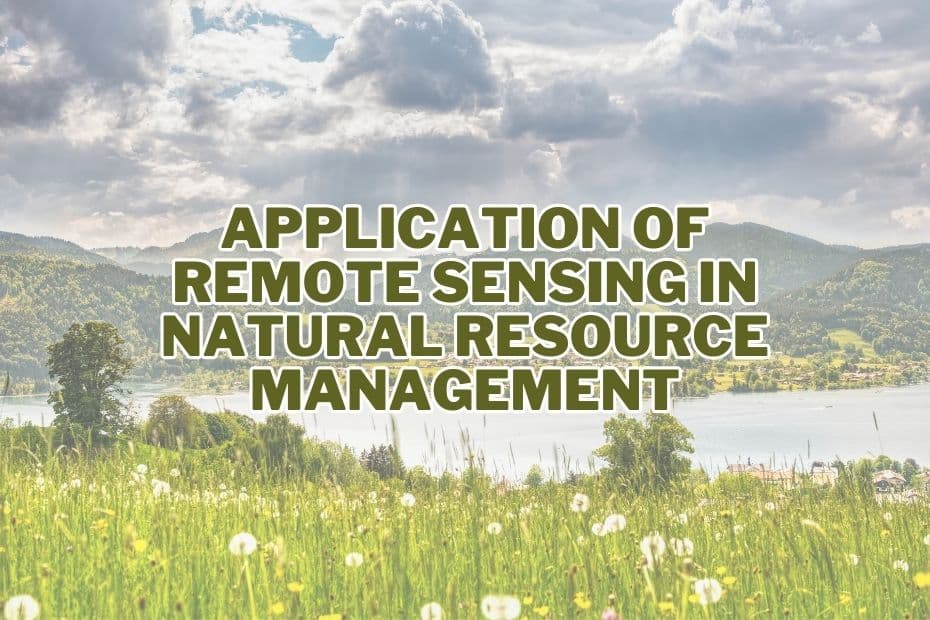Remote sensing, a technology that involves the collection of information about an object or phenomenon without being in direct physical contact, has revolutionized the way we manage natural resources. From monitoring environmental changes to aiding in disaster management, remote sensing offers a plethora of applications that contribute significantly to sustainable resource management. In this article, we’ll explore the key application of remote sensing in natural resource management.
Remote sensing enables the monitoring of forests, water bodies, and agricultural lands, aiding in conservation, resource allocation, and disaster management. By harnessing satellite data, remote sensing empowers informed decision-making for sustainable utilization of our natural resources.
Application of Remote Sensing In Natural Resource Management
In this technology-driven era, remote sensing has transcended traditional boundaries, enabling us to perceive our environment in ways we never thought possible.
By utilizing a variety of sensors, such as satellites and drones, remote sensing empowers us to gather data from remote locations with astonishing precision. This data holds the key to addressing some of the most pressing challenges in natural resource management.
1. Vegetation Monitoring for Biodiversity Conservation
Remote sensing plays a pivotal role in conserving biodiversity by enabling comprehensive vegetation monitoring. Satellite imagery provides detailed insights into changes in land cover, deforestation rates, and habitat alterations. This information aids in designing effective conservation strategies, identifying endangered species‘ habitats, and understanding ecological dynamics over time.
2. Soil Moisture and Agricultural Management
The agricultural sector benefits greatly from remote sensing technology. By analyzing soil moisture content through satellite-based sensors, farmers can optimize irrigation, prevent overwatering or drought stress, and enhance crop yields. This technology empowers precision agriculture, enabling targeted interventions and reducing water wastage.
3. Water Resource Management
The judicious management of water resources is vital for sustainable development. Remote sensing assists in monitoring water bodies, tracking changes in water levels, detecting pollution, and assessing the impact of human activities on aquatic ecosystems. This data-driven approach informs water resource planning, ensuring equitable distribution and minimizing environmental degradation.
4. Urban Planning and Land Use
In the rapidly urbanizing world, efficient urban planning is crucial. Remote sensing facilitates accurate land-use mapping, urban growth monitoring, and infrastructure development assessment. This information aids city planners in making informed decisions, optimizing land use, and ensuring sustainable urban expansion.
5. Natural Hazard Detection and Management
Timely identification of natural hazards such as hurricanes, earthquakes, and wildfires is paramount for disaster management. Remote sensing equips us with real-time monitoring capabilities, enabling swift response and evacuation plans. Satellite imagery helps assess damage extent, guiding relief efforts effectively.
6. Climate Change Assessment
Remote sensing offers a bird’s-eye view of climate change impacts. By capturing temperature variations, glacier retreat, sea-level rise, and deforestation rates, it provides crucial data for climate modeling. This aids researchers and policymakers in understanding trends, formulating mitigation strategies, and monitoring the effectiveness of climate policies.
7. Ecosystem Health and Restoration
Restoring and maintaining healthy ecosystems is a global priority. Remote sensing facilitates ecological assessment, tracking ecosystem health, and identifying areas in need of restoration. By monitoring changes in vegetation, water quality, and wildlife habitats, conservationists can make informed decisions to promote biodiversity and ecological balance.
8. Mineral Exploration and Mining
In the realm of natural resource extraction, remote sensing revolutionizes mineral exploration. Satellite data helps identify mineral deposits, assess their potential, and plan mining activities. This approach minimizes environmental impact by streamlining exploration efforts and optimizing resource extraction.
9. Ocean and Marine Resource Management
The oceans hold vast resources, but their sustainable management is challenging. Remote sensing aids in monitoring marine biodiversity, tracking pollution levels, and observing fishing activities. This information guides policies that ensure responsible marine resource utilization and safeguard fragile aquatic ecosystems.
10. Air Quality Monitoring
Air pollution poses significant health and environmental risks. Remote sensing technology enables real-time monitoring of air quality and the distribution of pollutants. By identifying pollution sources and tracking their dispersion patterns, authorities can implement targeted measures to improve air quality.
11. Archaeological and Cultural Heritage Preservation
Remote sensing isn’t limited to natural resources; it also aids cultural heritage preservation. Aerial imagery and LiDAR technology unveil hidden archaeological sites and historical structures. This assists archaeologists in exploration, documentation, and conservation of cultural treasures.
12. Coastal Zone Management
Coastal zones are vulnerable to climate change and human activities. Remote sensing monitors coastal erosion, sea-level rise, and changes in land cover. This information informs sustainable coastal zone management, safeguarding communities and ecosystems against adverse impacts.
13. Infrastructure Monitoring
Infrastructure maintenance is crucial for societal well-being. Remote sensing assists in monitoring infrastructure health, identifying structural issues, and predicting maintenance needs. This proactive approach ensures the longevity and safety of vital structures like bridges, dams, and pipelines.
Conclusion:
Remote sensing technology has revolutionized the management of natural resources across various domains. From conserving biodiversity to mitigating natural hazards and supporting sustainable development, its applications are diverse and impactful. By harnessing the power of remote sensing, we can make informed decisions that promote the responsible stewardship of our planet’s precious resources.
FAQs: Application of Remote Sensing In Natural Resource Management
What are some key benefits of remote sensing?
Remote sensing provides real-time data, covers vast areas, and minimizes the need for physical presence, making it cost-effective and efficient.
Is remote sensing limited to Earth?
While primarily used for Earth observation, remote sensing techniques have also been extended to study other celestial bodies in our solar system.
How does remote sensing contribute to air quality improvement?
Remote sensing technology allows real-time monitoring of air quality and pollutant distribution, helping authorities identify pollution sources and implement targeted measures to improve air quality.
